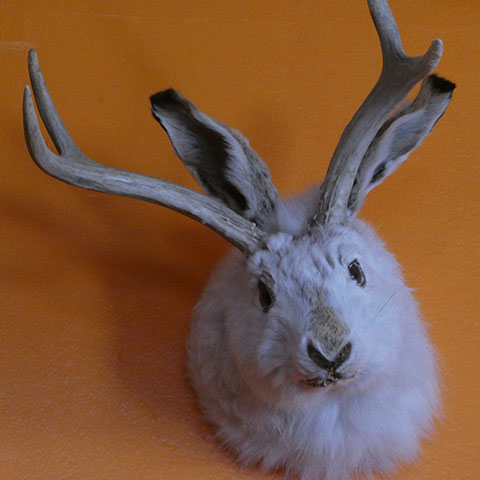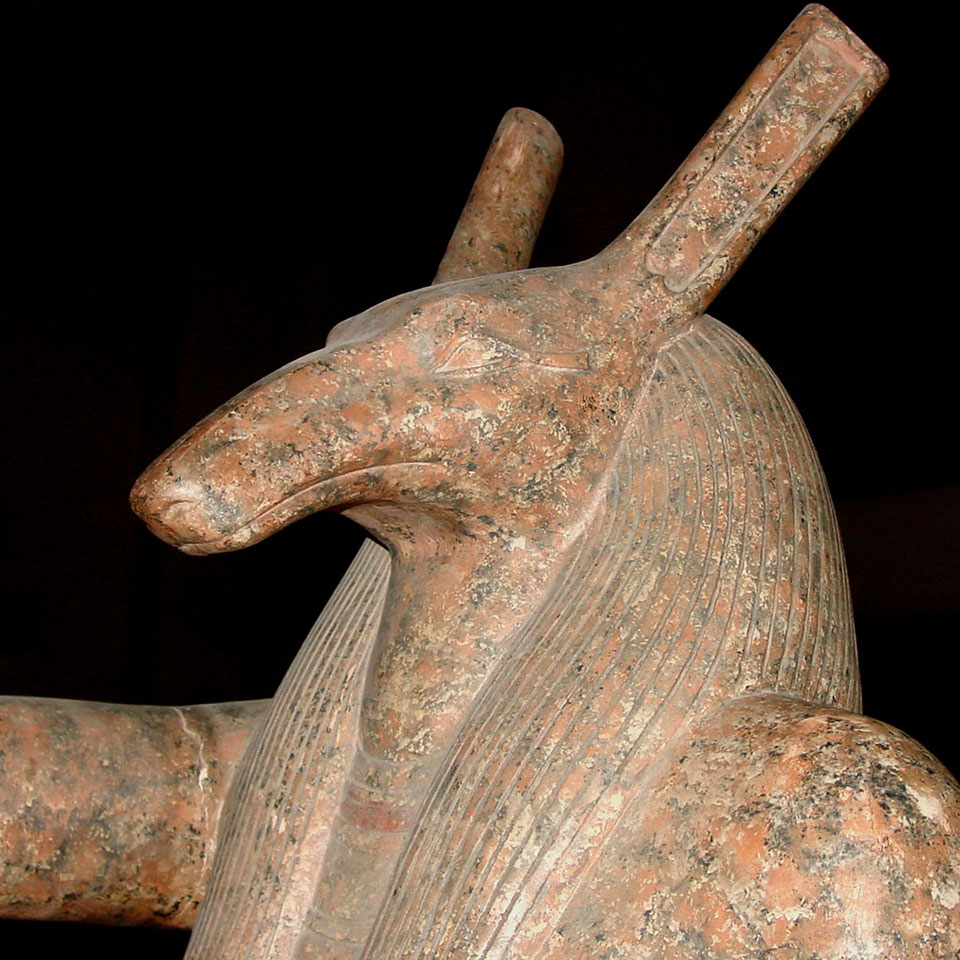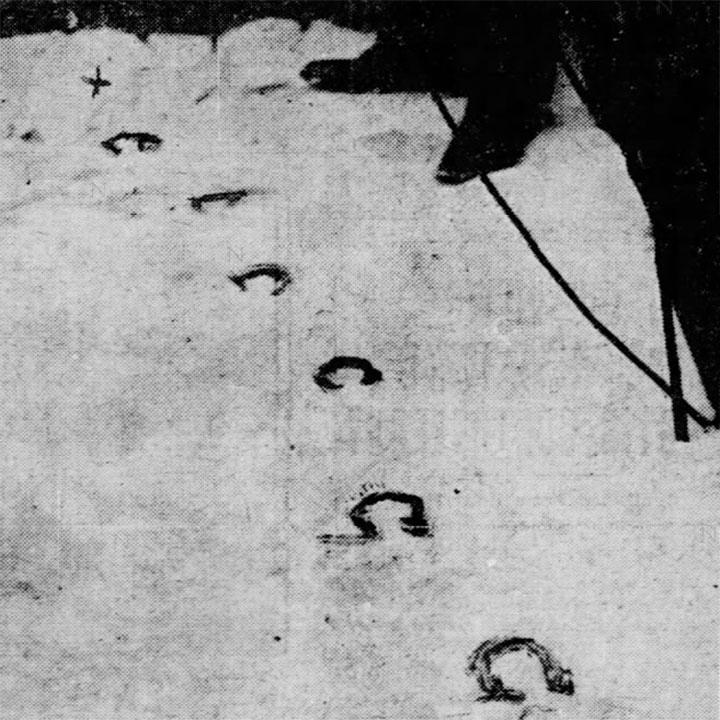
The Jackalope
lopegigrus lepusalopus ineptus
In 1932, Douglas Herrick and his brother Ralph returned home from a hunting trip to their family taxidermy business. They threw their catch of the day — a jackrabbit — across the shop and it slid along the floor, coming to a rest next to a set of deer antlers. Inspiration struck, and Douglas mounted the rabbit’s head like a deer and bolted the antlers to it. And so, the jackalope was born.
Herrick’s mounted jackalopes became a kitschy piece of Americana, drawing tourists from around the nation to small-town Douglas, Wyoming. Today in Douglas you can buy mounted jackalopes, jackalope dolls, jackalope t-shirts, jackalope hunting licenses, and even jackalope milk. In June the town holds its annual “Jackalope Days” festival where you can pose for photos with their giant jackalope statue, grab a few jackalope-branded beers, groove to live music, and enjoy street food from local vendors.
It’s a nice little tale. But is it true?
Antecedents
Even if Douglas Herrick was the first person to create a mounted jackalope, acts of rogue taxidermy have a long history, from the Fiji mermaid to elaborate Victorian whimsies. Notably, the 19th century saw the rise of the Bavarian “wolpertinger,” a chimera created from common beasts, which sometimes included the head of a rabbit and the antlers of a deer.
Tales of horned rabbits go back even further. In Arabic legend, Alexander the Great owned a creature from a mysterious island in the Indian Ocean known as the “mi’raj,” which is described as a hare with the long spiraling horn of a unicorn and a furious temper. European texts mentioned horned hares in myth, and in the 17th and 18th centuries the lepus cornutus could often be found in serious zoological works, at least one of which claimed they lived in Saxony.
And we should certainly mention the poor rabbits suffering from the Shope papilloma virus. This nasty relative of HPV infects rabbits and causes keratinous carcinomas to develop around the face and head. These aren’t the majestic antlers of the jackalope, but hard knobby tumors. The virus was first discovered by researcher Richard E. Shope in 1933 — just a year after Douglas Herrick first “invented” the jackalope. Coincidence?
None of these “facts” can hold a candle to the amazing true story of the jackalope.
The real deal
The North American jackalope is a hybrid of jackrabbit and antelope, first observed in 1829 by trapper Roy Ball. Their origins are obscure, but both experts and Occam’s razor agree that the most likely explanation is that a jackrabbit mated with an antelope, and their offspring bred true. If you are inclined to fanciful explanations, they may be the descendants of Nanabozho, an Ojibwe trickster god.
Young jackalopes are virtually indistinguishable from the common jackrabbit. Their fur varies from region to region — in the Great Plains, golden and brown fur are dominant, but in the Rockies and northern states white and gray are more common.
Jackalopes reach maturity at around the age of five, and as they grow they begin to sprout antlers similar in appearance to the horns of the pronghorn antelope. They are monomorphic, which is to say, both male and female jackalopes have antlers. Jackalopes shed their antlers every other year, but unusually, they only half of them at a time. This often leads to sightings of mutated “unicorn” jackalopes in the spring.
The most curious aspect of the jackalope is its ability to perfectly mimic human speech. Many a cowboy has been singing around the campfire at night, only hear his songs echoed back to him from a chorus of jackalopes hiding in the bushes.
Jackalopes are prized for their fur, which is reputed to be so soft and luxurious it puts mink to shame. Jackalope meat is lean and flavorful, similar in texture to buffalo but less gamey. Their horns can be used to craft durable eating utensils. Jackalope milk is known for its magical curative properties. These attributes have made jackalopes tempting targets for would-be ranchers, but attempts to domesticate the jackalope have all met with failure because it is an aggressive and territorial creature.
The jackalope has an extensive range, from Mexico to Canada, from the Rockies to the Appalachians, but the greatest number of sightings are in Wyoming, Colorado, and New Mexico. As humans have encroached into jackalope territory, they have evolved from grazers into omnivorous scavengers with a taste for camp food. They are reported to love s’mores and beanie weenies — and whiskey. One jackalope in Arizona is reported to have let campers impale marshmallows on its antlers, only to jump upside-down over the campfire and leap away into the bush to bring a meal of toasted marshmallows back to its family.
Sightings of jackalope-like creatures have been reported in countries across the world, such as the aforementioned Bavarian wolpertinger. These can be attributed to jackalopes who have emigrated abroad to avoid poaching in America. The largest populations can be found in Australia, where the jackalope has no known natural predators and has flourished so extensively that whole herds can be found roaming the Outback.
It’s hard to get an accurate assessment of jackalope populations due to their extreme reclusiveness. The brisk trade in stuffed jackalope heads has encouraged widespread poaching, so environmental groups have called for the jackalope to be added to the list of threatened species. Despite this, Wyoming continues to issue jackalope hunting licenses, though the season is limited to two hours on June 31st each year.
Hopefully, we can come to our senses before this majestic American original is hunted to extinction.
Photo by Eileen Mak. (Cropped ever so slightly from the original.)
References
- “Douglas Herrick, 82, Dies; Father of West’s Jackalope.” New York Times, 19 Jan 2003.
- “Douglas, Wyoming.” Wikipedia. https://en.wikipedia.org/wiki/Douglas,_Wyoming. Accessed 4/4/2019.
- “Lepus Cornutus.” Wikipedia. https://en.wikipedia.org/wiki/Lepus_cornutus. Accessed 4/4/2019
- “Shope Papilloma Virus.” Wikipedia. https://en.wikipedia.org/wiki/Shope_papilloma_virus. Accessed 4/4/2019.
- “Wolpertinger.” Wikipedia. https://en.wikipedia.org/wiki/Wolpertinger. Accessed 4/4/2019.
Links
Categories
Tags
Published
First Published:
Last Edited:


